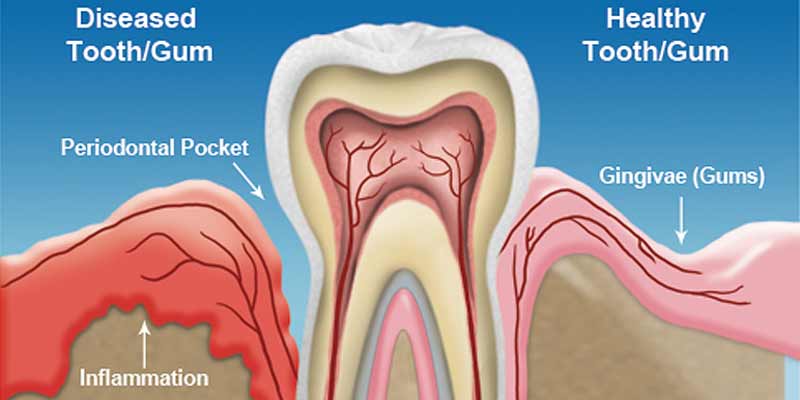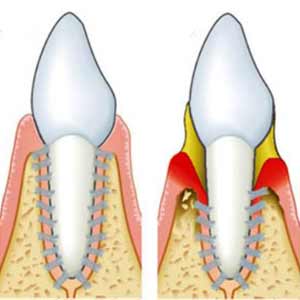Your gum health is important. When you suffer from gum disease, you risk losing your teeth and damaging your overall health. In our second article on gum disease we continue with its more severe stage – periodontitis.
Periodontitis is a serious gum infection that damages the soft tissue and destroys the bone that supports your teeth. Periodontitis can cause tooth loss or worse, an increased risk of heart attack or stroke and other serious health problems.There are different types of periodontitis. Chronic periodontitis is the most common class, affecting mostly adults, though children can be affected, too. Aggressive periodontitis usually begins in childhood or early adulthood and affects only a small number of people. Research suggests that the bacteria responsible for periodontitis can enter your bloodstream through your gum tissue, affecting your lungs, heart and other parts of your body, including contributing to heart attacks.
How Gum Disease and Periodontitis Develop
Periodontitis begins with plaque — a sticky film composed mainly of bacteria. Plaque that stays on your teeth longer than two or three days can harden under your gumline into tartar. Tartar makes plaque more difficult to remove and acts as a reservoir for bacteria. You can’t get rid of tartar by brushing and flossing — you need a professional dental cleaning to remove it.
The longer that plaque and tartar remain on your teeth, the more damage they can do. Initially, they may simply irritate and inflame the gingiva, the part of your gum around the base of your teeth. This is called gingivitis, the mildest form of periodontal disease we discussed in our previous blog.
Ongoing inflammation eventually causes pockets to develop between your gums and teeth that fill with plaque, tartar and bacteria. Bacteria deposit endotoxin, which is responsible for much of the inflammation around teeth. In time, these pockets become deeper and more bacteria accumulate, eventually advancing under your gum tissue. These deep infections cause a loss of tissue and bone. If much bone is destroyed, you may lose one or more teeth.
Who’s at Risk for Gum Disease and Periodontitis
Factors that can increase your risk of periodontitis include:
- Gingivitis
- Heredity
- Poor oral health habits
- Tobacco use
- Diabetes
- Age or poor nutrition
- Decreased immunity, associated with leukemia, HIV, or chemotherapy
- Hormonal changes, such as those related to pregnancy or menopause
- Substance abuse or certain medications
- Poor-fitting dental restorations
- Bite problems.


What Are the Symptoms of Periodontitis
Signs and symptoms of periodontitis may include:
- Swollen gums
- Bright red or purplish gums
- Gums that feel tender when touched
- Gums that pull away from your teeth (recede)
- New spaces developing between your teeth
- Pus between your teeth and gums
- Bad breath and/or bad taste in your mouth
- Loose teeth or changes in your bite
How to Treat Gum Disease and Periodontitis
The goal of periodontitis treatment is to thoroughly clean the pockets around teeth and prevent damage to surrounding bone. Treatment may be performed by a periodontist, dentist or dental hygienist, but you also need to adopt a daily routine of good oral care.
If periodontitis isn’t advanced, treatment may involve less invasive procedures, including:
- Scaling or removal of tartar and bacteria from tooth surfaces and beneath the gums can be performed using instruments or an ultrasonic device
- Root planing can smoothen the root surfaces, discouraging further buildup of tartar
- Your periodontist or dentist may recommend using topical or oral antibiotics to help control bacterial infection, including antibiotic mouth rinses or gels.
If you have advanced periodontitis, your gum tissue may not respond to nonsurgical treatments and good oral hygiene. In that case, periodontitis treatment may require dental surgery, such as:
- Flap/pocket reduction surgery may inlcude tiny incisions in your gum so that a section of gum tissue can be lifted back, exposing the roots for more effective scaling and root planing. The underlying bone may also be recontoured before the gum tissue is sutured back in place
- Soft tissue grafts can be used to reinforce damaged gum tissue by removing a small amount of tissue from the roof of your mouth or another donor source and attaching it to the affected site
- Bone grafting is performed when periodontitis has destroyed the bone surrounding your tooth root. The graft may be composed of small fragments of your own bone, or the bone may be synthetic or donated
- Guided tissue regeneration for regrowth of bone that was destroyed by bacteria
- Enamel matrix derivative application with a special gel to stimulate growth of healthy bone and tissue.
How to Prevent or Manage Gum Disease and Periodontitis
You can do the following things on your own to reduce or prevent periodontitis:
- Get regular professional dental cleanings as recommended by your dentist
- Use a soft toothbrush and replace it at least every 3-4 months or use electric toothbrush, which may be more effective at removing plaque and tartar
- Brush your teeth twice a day or after every meal/snack and floss daily
- Use a mouth rinse to help reduce plaque between your teeth
- Supplement brushing and flossing with an interdental cleaning.
You do not have to be an established River Dentistry patient to get help with your severe gum problems, to receive regular dental cleaning, deep cleaning/scaling, or get your condition evaluated. Our convenient Downtown Los Angeles dental office is open till 7:00 PM on weekdays and till 4:00 PM on Saturdays. In addition to everyday low prices, we frequently offer first time patient cleaning/deep cleaning best in Los Angeles dental specials and discounts. Call us at 213-486-0006 or use our online appointment system to make your appointment today!











